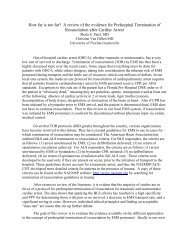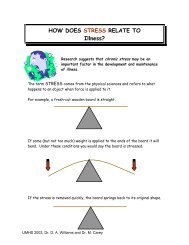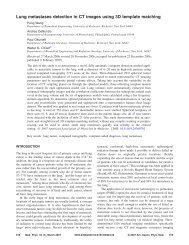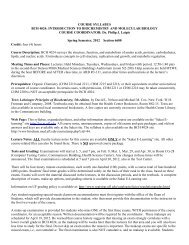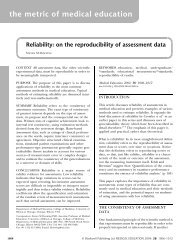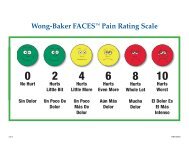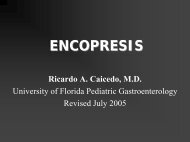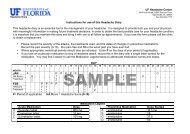imaging three-dimensional cardiac function - Walter G. O'Dell, PhD
imaging three-dimensional cardiac function - Walter G. O'Dell, PhD
imaging three-dimensional cardiac function - Walter G. O'Dell, PhD
Create successful ePaper yourself
Turn your PDF publications into a flip-book with our unique Google optimized e-Paper software.
446 O’DELL MCCULLOCHAnnu. Rev. Biomed. Eng. 2000.2:431-456. Downloaded from arjournals.annualreviews.orgby UNIVERSITY OF ROCHESTER LIBRARY on 07/27/09. For personal use only.?Model-Based Deformation Analysisvelocity-encoding methods are inherently difficult because the tagged regions oftissue contain no velocity information (are a signal void), and the velocity encodingstep requires a reference and a phase-encoding image; thus it does notoffer an overall time advantage compared with 3-D tagging or 3-D phase-contrast<strong>imaging</strong>.Reconstruction of the 3-D strain field from discrete samples of displacement requiresan interpolation scheme to describe the motion between samples in space, tocorrect for noise in the sampling, and to compute the local displacement gradientsthat are used for strain calculation (unless explicitly stated, considerations for velocityfield and strain rate reconstruction can be assumed to be analogous to thosedescribed here for displacement field and strain reconstruction). The interpolationmethod usually includes a model of the 3-D displacement field. A priori assumptionsof the displacement field can be used to generate a model that contains theexpected modes of motion, and the displacement or velocity samples can be usedto optimize the magnitude and direction of those modes (55).A more general formulation is to use 3-D basis <strong>function</strong>s to describe the localmotion within each element of a finite element model of the heart (89), increasingthe number of degrees of freedom in the reconstruction to the number of localbasis <strong>function</strong>s per element times the number of elements. Taking this globally, amodel containing hundreds of candidate modes can be formulated, and the sampledmotion can be used to solve for the magnitude of those modes over the entireheart. This removes the requirement for a priori assumptions about the modesof motion, useful for reconstructing motions in regions of altered mechanicalstate, such as sites of ischemia. O’Dell et al (53) use a displacement field fittedto a polynomial series in prolate spheroidal coordinates (a 3-D analogy to the2-D surface reconstruction presented earlier) to reconstruct 3-D material pointtrajectories from parallel-tag data sets. As shown in Figure 2 (see color insert), thecontribution of each mode to the overall motion of the heart can be quantified andinterpreted independently by using computer models of the heart (90).Another interesting approach, presented by Denney et al (91), uses samplesof motion along with energy minimization equations that penalize large gradientsin deformation to estimate the motion at each point in a rectangular grid thatencompasses the entire heart. This approach is related to optical-flow techniquesand is a powerful model-free method of computational analysis.Limitations of the ReconstructionsUltimately, the resolution and accuracy of the results from a reconstruction schemeare determined by the deformations of the heart tissue and the density and quality oforiginal motion sampling. First, if the motion is simple, for example, the translationof a solid body, only a few simple parameters and a few samples of motions



